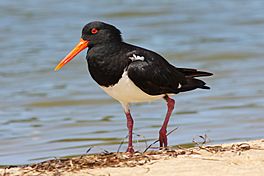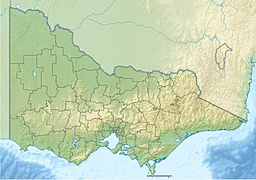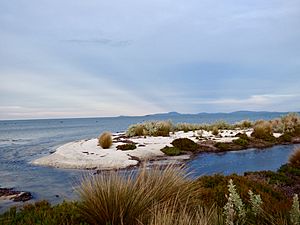Corner Inlet facts for kids
Quick facts for kids Corner Inlet |
|
|---|---|

Corner Inlet is an important site for pied oystercatchers
|
|
| Location | South Gippsland, Victoria |
| Coordinates | 38°45′57″S 146°20′21″E / 38.76583°S 146.33917°E |
| Primary inflows |
|
| Primary outflows | Bass Strait |
| Basin countries | Australia |
| Surface area | 600 km2 (230 sq mi) |
| Islands | Snake, Sunday and Saint Margaret |
| Designated: | 15 December 1982 |
| Reference #: | 261 |
Corner Inlet is a large bay in Victoria, Australia. It covers about 600 square kilometres (230 sq mi) (which is about 230 square miles). You can find it about 200 kilometres (120 mi) (124 miles) south-east of Melbourne.
This bay is special because it's the easternmost and warmest of Victoria's big bays. It has many different natural habitats. These include muddy areas that are covered and uncovered by tides (called intertidal mudflats). You'll also find mangroves (trees that grow in salty water), salt marshes (grassy areas flooded by tides), and seagrass meadows (underwater grass beds).
Corner Inlet is protected from the big waves of Bass Strait. This protection comes from a group of 40 sandy islands. The biggest of these are Snake, Sunday, and Saint Margaret Islands.
The inlet is a very important natural area. It is protected as a Ramsar site. This means it's recognized internationally for its wetlands. It's also part of the Nooramunga and Corner Inlet Marine and Coastal Parks. A section of the inlet is within the 1,550-hectare (3,800-acre) Corner Inlet Marine National Park. The bay is next to Wilsons Promontory in the west. It stretches towards Ninety Mile Beach in the east. Many migratory birds and other animals live here.
A Look at the Past: Corner Inlet's History
Corner Inlet is on the traditional lands of the Brataolong clan. These people are part of the Gunai nation. They have lived here for a very long time.
In the early 1840s, European settlers arrived in the area. They started farms, mines, and logging businesses. Fishing for a living began in the 1860s. Most of the forests around the inlet were cleared over time. Today, Corner Inlet is a popular place for tourists. People enjoy recreational boating and fishing here.
Amazing Birds of Corner Inlet
A large area of land and water around Corner Inlet is very important for birds. It's recognized as an Important Bird Area by BirdLife International. This area covers about 720 square kilometres (280 sq mi).
Corner Inlet has the biggest intertidal mudflats in Victoria. These muddy areas are perfect for many birds. More than 1% of the world's population of certain birds live here. These include the chestnut teal, Far Eastern curlew, and red-necked stint. You can also see many pied and sooty oystercatchers. The hooded plover also calls this place home.
Sometimes, a very rare bird called the orange-bellied parrot is seen here. This bird is critically endangered. This means it's at a very high risk of disappearing forever. Protecting places like Corner Inlet helps these special birds survive.



